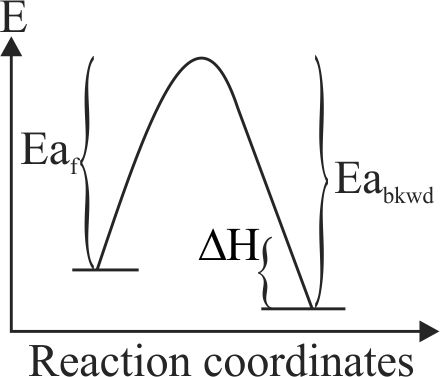320104 The rate constants \({\rm{k}}\,\,{\rm{and}}\,\,{{\rm{k}}_{\rm{2}}}\) for two different reactions are \({\rm{1}}{{\rm{0}}^{{\rm{16}}}}{{\rm{e}}^{{\rm{ - 2000/T}}}}\,\,{\rm{and}}\,\,{\rm{1}}{{\rm{0}}^{{\rm{15}}}}{{\rm{e}}^{{\rm{ - 1000/T}}}}\) respectively. The temperature at which \(k_{1}=k_{2}\) is
320104 The rate constants \({\rm{k}}\,\,{\rm{and}}\,\,{{\rm{k}}_{\rm{2}}}\) for two different reactions are \({\rm{1}}{{\rm{0}}^{{\rm{16}}}}{{\rm{e}}^{{\rm{ - 2000/T}}}}\,\,{\rm{and}}\,\,{\rm{1}}{{\rm{0}}^{{\rm{15}}}}{{\rm{e}}^{{\rm{ - 1000/T}}}}\) respectively. The temperature at which \(k_{1}=k_{2}\) is
320104 The rate constants \({\rm{k}}\,\,{\rm{and}}\,\,{{\rm{k}}_{\rm{2}}}\) for two different reactions are \({\rm{1}}{{\rm{0}}^{{\rm{16}}}}{{\rm{e}}^{{\rm{ - 2000/T}}}}\,\,{\rm{and}}\,\,{\rm{1}}{{\rm{0}}^{{\rm{15}}}}{{\rm{e}}^{{\rm{ - 1000/T}}}}\) respectively. The temperature at which \(k_{1}=k_{2}\) is
320104 The rate constants \({\rm{k}}\,\,{\rm{and}}\,\,{{\rm{k}}_{\rm{2}}}\) for two different reactions are \({\rm{1}}{{\rm{0}}^{{\rm{16}}}}{{\rm{e}}^{{\rm{ - 2000/T}}}}\,\,{\rm{and}}\,\,{\rm{1}}{{\rm{0}}^{{\rm{15}}}}{{\rm{e}}^{{\rm{ - 1000/T}}}}\) respectively. The temperature at which \(k_{1}=k_{2}\) is

